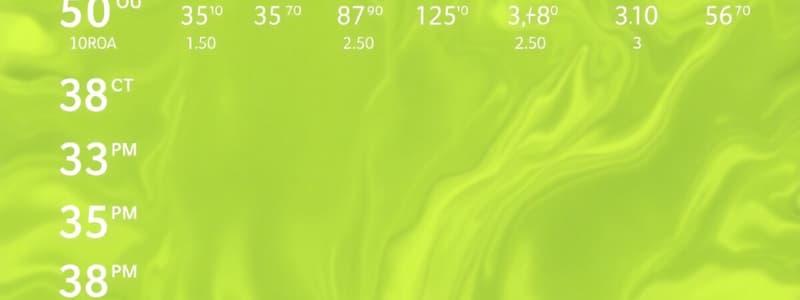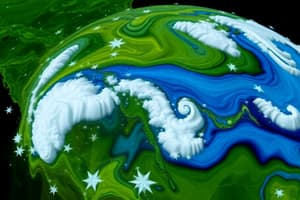Podcast
Questions and Answers
A hygrometer's function is BEST described as measuring:
A hygrometer's function is BEST described as measuring:
- the water content in the air by assessing electrical conductivity. (correct)
- the electrical conductivity of air to determine air pressure.
- the amount of electrical charge in the atmosphere to predict storms.
- the temperature of the air using electrical resistance.
Weather satellites are particularly useful for observing which weather phenomena?
Weather satellites are particularly useful for observing which weather phenomena?
- Precise wind speeds in the lower atmosphere.
- Large-scale cloud formations and precipitation patterns. (correct)
- Detailed temperature variations at ground level.
- Localized humidity levels in urban areas.
In weather forecasting, what is a key advantage of using weather balloons compared to satellites?
In weather forecasting, what is a key advantage of using weather balloons compared to satellites?
- Balloons are more effective at measuring precipitation intensity over oceans.
- Balloons offer direct measurements of atmospheric conditions within weather systems. (correct)
- Balloons can transmit data faster and more reliably than satellites.
- Balloons can provide continuous, real-time imagery of cloud cover.
Why are aircraft less suited for measuring wind speed compared to weather balloons?
Why are aircraft less suited for measuring wind speed compared to weather balloons?
What is the primary role of weather stations in the overall weather data collection process?
What is the primary role of weather stations in the overall weather data collection process?
To gain a comprehensive understanding of atmospheric conditions, weather forecasting relies on:
To gain a comprehensive understanding of atmospheric conditions, weather forecasting relies on:
The ultimate goal of employing various weather measurement tools like satellites and balloons is to:
The ultimate goal of employing various weather measurement tools like satellites and balloons is to:
Which of the following best describes the primary purpose of collecting weather data?
Which of the following best describes the primary purpose of collecting weather data?
A sudden drop in atmospheric pressure, as measured by a barometer, most likely indicates:
A sudden drop in atmospheric pressure, as measured by a barometer, most likely indicates:
How do radar systems primarily gather data about precipitation?
How do radar systems primarily gather data about precipitation?
If a transmissometer reading indicates a significant reduction in light detected, which weather condition is most likely present?
If a transmissometer reading indicates a significant reduction in light detected, which weather condition is most likely present?
Which combination of instruments would be most useful in determining the overall moisture content and movement of air in a specific location?
Which combination of instruments would be most useful in determining the overall moisture content and movement of air in a specific location?
A meteorologist observes that a wind vane is pointing east and an anemometer is recording high wind speeds. What can be concluded from these observations?
A meteorologist observes that a wind vane is pointing east and an anemometer is recording high wind speeds. What can be concluded from these observations?
A location at high altitude would show different readings on which of the following instruments compared to a location at sea level, assuming similar weather conditions?
A location at high altitude would show different readings on which of the following instruments compared to a location at sea level, assuming similar weather conditions?
A farmer is using weather data to decide when to plant crops. Which combination of data would be most useful?
A farmer is using weather data to decide when to plant crops. Which combination of data would be most useful?
Flashcards
Hygrometer
Hygrometer
Instrument that measures the amount of water vapor in the air.
Weather Satellites
Weather Satellites
Man-made objects orbiting Earth that are used to measure clouds and precipitation from space.
Weather Balloons
Weather Balloons
Floating balloons containing weather equipment to measure pressure, temperature, humidity, and wind speed.
Aircraft (weather)
Aircraft (weather)
Signup and view all the flashcards
Weather Stations
Weather Stations
Signup and view all the flashcards
Weather Cameras
Weather Cameras
Signup and view all the flashcards
Weather Radar Systems
Weather Radar Systems
Signup and view all the flashcards
Weather Data
Weather Data
Signup and view all the flashcards
Thermometer
Thermometer
Signup and view all the flashcards
Radar System
Radar System
Signup and view all the flashcards
Barometer
Barometer
Signup and view all the flashcards
Rain Gauge
Rain Gauge
Signup and view all the flashcards
Wind Vane
Wind Vane
Signup and view all the flashcards
Anemometer
Anemometer
Signup and view all the flashcards
Transmissometer
Transmissometer
Signup and view all the flashcards
Study Notes
- Weather data is essential for predicting weather patterns and understanding the atmosphere.
- It includes facts and figures about atmospheric conditions like temperature, wind speed, precipitation, humidity, and pressure.
- Modern technology enables accurate measurements from the ground, air, and space.
Data Collection Devices
- Thermometers measure temperature via liquid expansion or digital sensors.
- Radar systems map rain and snow and measure cloud motion by bouncing radio waves.
- Barometers measure atmospheric pressure, indicating air density.
- Rain gauges measure the amount of rainfall collected in a container.
- Wind vanes indicate wind direction using a sail.
- Anemometers measure wind speed using rotating cups.
- Transmissometers measure visibility by assessing light loss through the air.
- Hygrometers measure humidity by assessing electrical conductivity in the air.
Satellites, Balloons, Aircraft, and Stations
- Satellites orbiting Earth measure cloud size, motion, and precipitation using cameras and radar.
- Weather balloons measure pressure, temperature, humidity, and wind speed.
- Aircraft aid in gathering data.
- Weather stations on the ground collect data using various devices and coordinate data from other sources like satellites, aircraft, and balloons.
- Combining data from weather stations, satellites, balloons, and aircraft gives a complete view of the Earth's atmospheric conditions, which helps in weather prediction.
Studying That Suits You
Use AI to generate personalized quizzes and flashcards to suit your learning preferences.
Description
Weather data includes atmospheric conditions like temperature, precipitation, and pressure. Modern tech allows accurate measurements from ground, air, and space using tools like thermometers and radar. Satellites, balloons, aircraft, and stations collect weather data.




